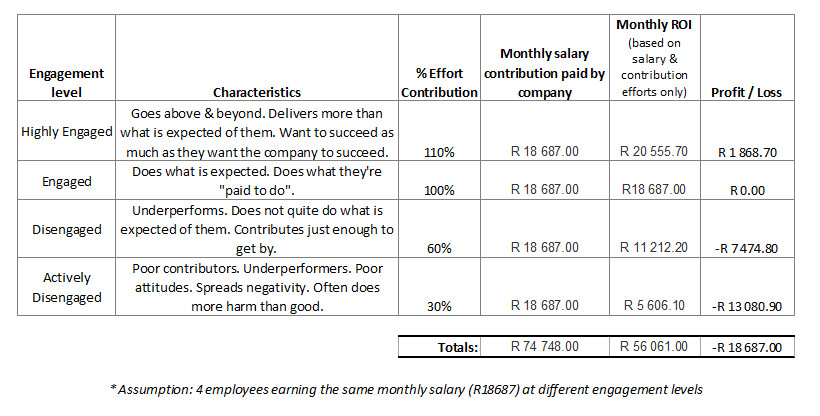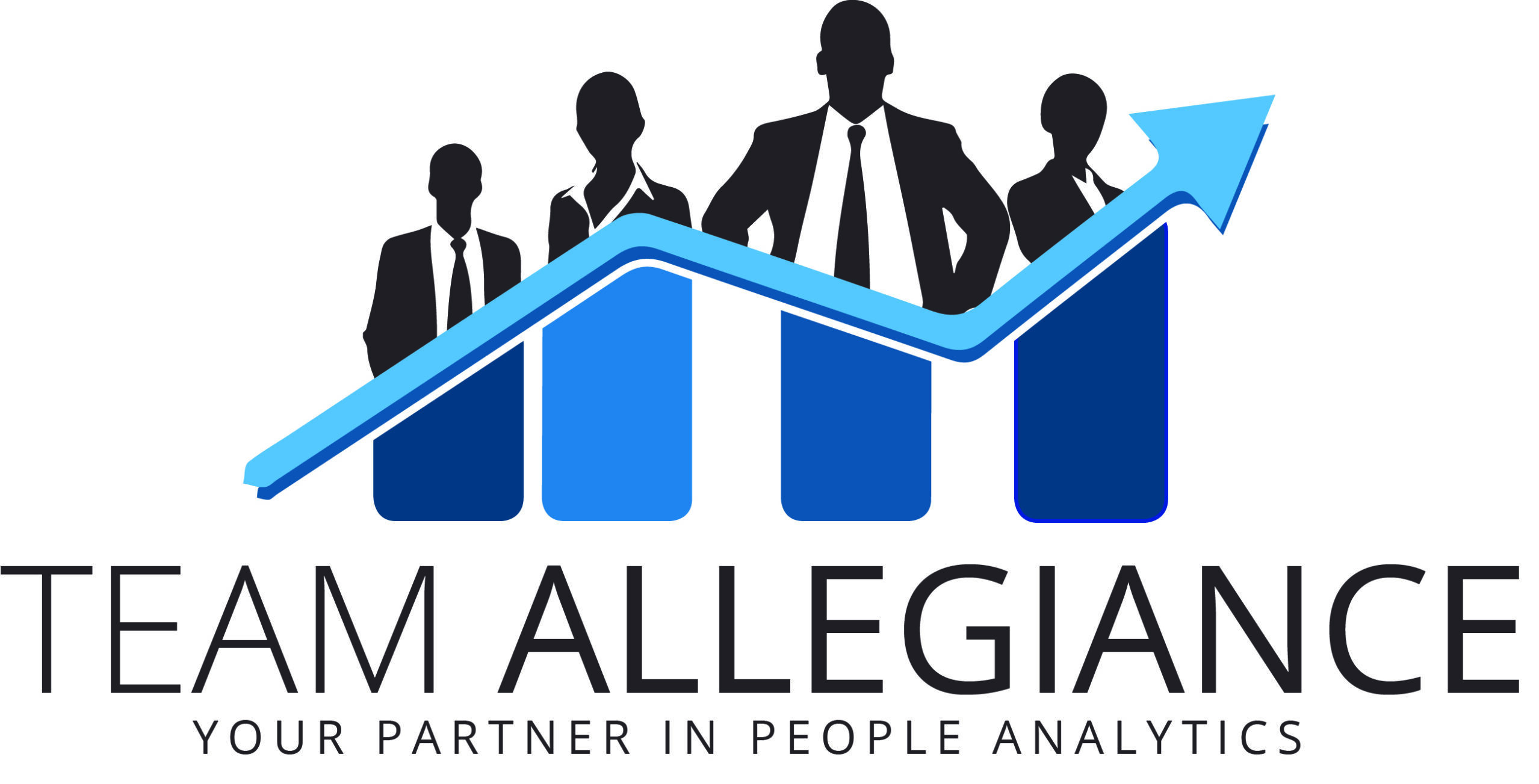Employee Engagement – the basics
Defining Employee Engagement
Employee Engagement can fundamentally be described as the relationship between an organisation and its employees. The importance of understanding the nature of this relationship can’t be overstated as employee engagement strategies have been proven to; reduce absenteeism, staff turnover and accidents in the workplace. It also has a positive impact on innovation, productivity, efficiency and service delivery to customers resulting in higher customer retention. All these elements carry a financial cost which constitutes a higher return on employee investment and higher business profits.
Benefits are however not only limited to the organisation but shared by its workforce as engaged employees have a higher sense of belonging, job satisfaction and are generally happier at work.
It is important to note that engagement and satisfaction are very different things. Employees can be satisfied but NOT engaged. Coming to work and chatting with colleagues, browsing the web all day, downloading movies and music using the company’s internet, updating your social media status ten times a day and playing Foosball in the canteen may be very satisfying to employees, but is it contributing towards the success of the company?
The Engaged Employee
An engaged employee is defined as one who feels passionate and enthusiastic about their work and the organisation they work for. They have positive attitudes and a strong sense of pride, loyalty and belonging to their organisation. They feel aligned with and are committed to the organisation’s goals, success and values. They take positive action to further the organisation’s reputation and interests. These employees are brand ambassadors and not only deliver exceptional service but also attract like-minded talent.
Imagine if all employees were passionate about their work and the success of their company! Unfortunately this is not the case.

If we were to use a rowing team consisting of 10 rowers as an analogy for the state of Employee Engagement in South-Africa; 1 person would be actively rowing, trying to get your team to the finish line, 5 people would lounge around and occasionally put one oar in the water and give a sweep or two and 4 people would be rowing in the opposite direction.
Employee Engagement – ROI

Disengagement has huge financial implications for companies. If we look at a basic example of ROEI (Return on Employee Investment) in the table below, we get a glimpse of the financial impact disengagement has on organisations. Note that this table is not based on exact measurement but merely used for demonstrative purposes.

This table only takes contribution / performance / productivity into consideration. Different levels of engagement directly and indirectly impact on your bottom line in many other ways i.e.
* Absenteeism
- Unauthorised and unplanned absenteeism is a good indicator of workplace dissatisfaction and staff disengagement. Employees who don’t feel motivated and are not committed to their work or their company are more likely to miss work than their counterparts.
- Unexpected absenteeism can also result in missed deadlines, loss of productivity and increased stress and workload for team members who need to take on other’s work.
- Disengagement can also have an effect on an individual’s physical well-being resulting in legitimate absenteeism.
- Paid sick leave and the hiring of temp or replacement staff are just some costs associated with absenteeism. Engaged workers take fewer sick days and are less likely to skip work.
* Staff retention
- A high employee turnover rate is often also an indication of employee disengagement.
- In lower staff turnover companies who have high staff engagement, turnover is 25% lower than in that of companies with highly disengaged staff. In high staff turnover organisations, the difference is as big as 65%.
- There is a significant business cost to replacing employees. The total cost of replacing an employee is estimated to be between 30% and 80% of their annual salary and can soar up to 200% for Exec level employees. Replacement costs include items such as advertising, recruiting, interviewing, hiring, orientation, training, administrative costs, time invested by mangers and team leaders, and lower productivity while the new employee gets up to speed with their new job.
- Though not often calculated, lost knowledge also carry a high cost.
- Exceptional staff is often lost because they become disengaged and disengaged staff often remain because they have nowhere to go. It is vital to engage both groups as you don’t want your top employees to leave and you want to grow underperforming staff into top employees.
* Safety incidents
- Engaged employees are invested in their work and go out of their way to ensure that things are done right.
- Engaged staff have a sense of ownership and heightened awareness of their role. They are therefore likely to notice safety hazards, speak up about it, make suggestions for improvements and implement changes successfully.
- Disengaged staff on the other hand are less focused and more likely to make mistakes. They often don’t report safety hazards or minor incidents. They are “checked out”; showing little interest in safety rules and often breaks these rules or takes shortcuts, becoming safety risks themselves.
- The average cost of a safety incident for a disengaged employee is up to five times as high as for that of an engaged employee.
- Except for the financial cost there is also a human cost when safety issues occur. Employee Engagement is key when it comes to safety in the workplace.
* Innovation
- Employees with a sense of purpose tend to be more engaged. This particularly applies to millennials since 84% of millennials seek purposeful work. Engaged employees drive innovation as they are empowered to seek ways to innovate.
- Open communication lines promote idea sharing and collaboration. When employees are listened to, they become more comfortable with sharing their ideas which naturally increases their engagement levels.
- These employees are eager to find new ways to help the organisation grow, improve and meet their goals. They find a purpose and feel invested in the organisation. The more an employee feels personally invested in a company’s purpose, the more likely they are to work hard and serve it.
- Opportunities to be innovative drives Employee Engagement and research shows that engaged employees are more innovative.
* Customer Satisfaction
- Employee Engagement is directly linked to customer satisfaction and customer satisfaction is directly linked to financial performance.
- Studies show that organisations with high employee engagement measure higher on Customer Experience (CX) studies than companies with disengaged staff.
- According to the 2nd annual PDT report – “The state of employee engagement in RSA”, every 5% increase in engagement leads to 3% increase in revenue. An engaged workforce can truly impact and drive revenue. A higher customer satisfaction score translates into customers using your products and services more often and lower customer churn.
- Satisfied customers cost less to serve and are more profitable customers. Customer satisfaction in turn drives Employee Engagement.
- In Employee Engagement studies, we often ask employees the question: “What is the best thing about working for your company?” In companies where employees are engaged, the response is often something like “to see my customers smile” or “making our customers happy”.
- A positive customer experience can reinforce an employee’s pride, value and purpose in their work.
* Company image
- Your employees ARE your brand.
- When you visit BANK X and the person behind the counter is rude and unable or unwilling to assist you, you might raise this issue with friends. When this happens, you hardly ever say John Doe is such an incompetent employee, you say that BANK X is a terrible bank.
- Similarly, when you phone a call centre for assistance and the agent does not know the product well enough to assist you properly. This frustration is increased when you speak to a second agent who is also unable to assist you. You hardly tell friends or colleagues that Company X has two agents who deliver poor customer service; the word that gets spread around is that YOUR COMPANY delivers poor customer service.
- Employees also talk socially about work and about your company. Are they saying that YOUR COMPANY is a good place to work or are they constantly telling people what an unpleasant environment it is?
- An organisations reputation is highly dependent on their staff’s engagement levels. Engaged staff are aligned with company goals and strategies and strive to do what is best for the company. They are brand ambassadors who represent your company in a positive way. Brand ambassadors attract customers and other engaged staff to your organisation.
Investing in Employee Engagement initiatives is often seen as a ‘nice to have’ and an unnecessary expense but the proof is in the research which shows that businesses with more engaged employees perform better. Disengaged employees cost companies hundreds of thousands in annual profits. Knowing the engagement levels in your organisation and understanding what drives these attitudes and behaviours can deliver a competitive advantage. The cost of disengagement is too high to simply ignore it.
If you’re still in doubt and need to see the figures for yourself, we have made our Employee Engagement ROI calculator available to the public (See our ‘free resources’ page). This tool is designed to help you justify investment in engagement boosting initiatives by understanding the financial impact of your organisation’s current level of engagement.
“It is essential that the focus of companies is to improve, not only measure, engagement. If they are committed to acting on the results of the surveys, employee engagement will increase as a result of these actions.”
I would personally recommend Employee Engagement initiatives to any organisation as the benefits are countless. Each organisation has its own culture and engagement strategies. Roll out an engagement study in your organisation to determine how YOUR employees feel about YOUR Company so you can build on your unique employee experience to make the workplace a happy, productive and engaged space.
We wish you and your team and exciting 2018 filled with delighted customers and fully engaged employees!







